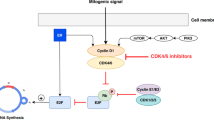Abstract
Purpose: The dolastatins are a class of naturally occurring cytotoxic peptides which function by inhibiting microtubule assembly and tubulin polymerization. Cemadotin is a synthetic analogue of dolastatin 15 with potent antiproliferative and preclinical antitumor activity. This report describes a phase I study to evaluate the administration of cemadotin to adult cancer patients by a 5-day continuous intravenous (CIV) infusion. Methods: All patients had histologically confirmed refractory solid tumors. The dose was escalated from an initial level of 2.5 mg/m2 (0.5 mg/m2 daily) according to a modified Fibonacci algorithm. A minimum of three patients was evaluated at each dose level until the maximum tolerated dose (MTD) was established. Treatment was repeated every 21 days until patients were removed from the study due to toxicity or disease progression. Drug-related toxicities were evaluated and graded by the U.S. National Cancer Institute's Common Toxicity Criteria. A radioimmunoassay (RIA) that detected both the parent drug and its metabolites with an intact N-terminal region of the molecule was used for pharmacokinetic studies. Results: Twenty heavily pretreated patients received a total of 40 courses of cemadotin over five dose levels ranging from 2.5 to 17.5 mg/m2. Reversible dose-related neutropenia was the principal dose-limiting toxicity and 12.5 mg/m2 was established as the MTD. Nonhematologic toxicities attributed to the drug were moderate, and there was no evidence of the cardiovascular toxicity noted in the prior phase I studies of cemadotin given IV as a 5-min injection or 24-h infusion. There were no objective antitumor responses. Time courses of the cemadotin RIA equivalent concentration in whole blood were defined in 14 patients during the first cycle of therapy. The RIA-detectable species exhibited apparent first-order pharmacokinetics across the entire range of doses. The mean ± SD of the observed steady-state blood concentration at the 12.5 mg/m2 MTD was 282 ± 7 nM (n=3). Blood levels decayed monoexponentially following the end of the infusion, with a mean half-life of 13.2 ± 4.3 h (n=14) in all patients. Mean values (n=14) of the total blood clearance and apparent volume of distribution at steady state were 0.52 ± 0.09 l/h/m2 and 9.9 ± 3.3 l/m2, respectively. Conclusions: The cardiotoxic effects of cemadotin were completely avoided by administering it as a 120-h CIV infusion. Thus, cardiovascular toxicity appears to be associated with the magnitude of the peak blood levels of the parent drug or its metabolites, whereas myelotoxicity is related to the duration of time that blood levels exceed a threshold concentration. Nevertheless, the data acquired during the extensive clinical experience with cemadotin requires careful examination to assess whether advancing this compound into disease-oriented efficacy studies is merited.
Similar content being viewed by others
Author information
Authors and Affiliations
Additional information
Received: 8 November 1999 / Accepted: 28 April 2000
Rights and permissions
About this article
Cite this article
Supko, J., Lynch, T., Clark, J. et al. A phase I clinical and pharmacokinetic study of the dolastatin analogue cemadotin administered as a 5-day continuous intravenous infusion. Cancer Chemother Pharmacol 46, 319–328 (2000). https://doi.org/10.1007/s002800000152
Issue Date:
DOI: https://doi.org/10.1007/s002800000152




